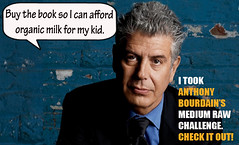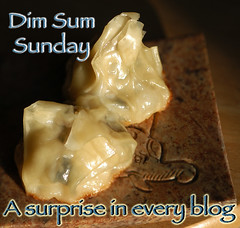 It was the first thing that caught my eye as I headed into my grocery store. How could it not? Bright red, yellow and orange flesh glowing like neon. It was beautiful. Stunning...It was, well, gastropornographic. I had to buy some, if only to pay homage with my trusty Nikon. But once I had paid for the objects of my obsession, I began to wonder...does orange watermelon differ in taste from red or yellow?
It was the first thing that caught my eye as I headed into my grocery store. How could it not? Bright red, yellow and orange flesh glowing like neon. It was beautiful. Stunning...It was, well, gastropornographic. I had to buy some, if only to pay homage with my trusty Nikon. But once I had paid for the objects of my obsession, I began to wonder...does orange watermelon differ in taste from red or yellow?One of the things that I like about Top Chef are the challenges they devise to test the chefs palates. Identify the ingredient. Identify the better quality product versus it's cheaper alternative. A refined palate is not something that comes as standard equipment on every chef. It has to be developed; trained. So the color of the melons fascinated me . Can you taste color? Was one color of melon selling better than another? Would the feng shui of the orange melon fit in someones kitchen better than the red?
 My quest went on. We all know what happened to the mighty lunch box apple. Once upon a time there was a fantastic apple called the Red Delicious. These days, it's certainly still red - but delicious? No, I think in the drive for that eye pleasing shape, color and juiciness, the poor Red Delicious developed into a pale tasting ghost of it's former self and nearly took down the State of Washington's apple industry with it.
My quest went on. We all know what happened to the mighty lunch box apple. Once upon a time there was a fantastic apple called the Red Delicious. These days, it's certainly still red - but delicious? No, I think in the drive for that eye pleasing shape, color and juiciness, the poor Red Delicious developed into a pale tasting ghost of it's former self and nearly took down the State of Washington's apple industry with it. Is that what's happening with all varieties of fruit and veggies? Is some marketing minion somewhere giving a Power Point presentation about the advantages of style over substance? Are we breeding out the taste as they breed in the PR Buck Banger? Could we taste the difference if they had? If you boiled each of these potatoes and served them to someone blindfolded could they tell the difference between the three? Would the waxiness of one potato give it away? How many people buy purple potatoes to see if their mashed potatoes will turn out the same vibrant hue as the flesh, or fade to a pale lavender with cooking? (OK maybe that was just me.)
Is that what's happening with all varieties of fruit and veggies? Is some marketing minion somewhere giving a Power Point presentation about the advantages of style over substance? Are we breeding out the taste as they breed in the PR Buck Banger? Could we taste the difference if they had? If you boiled each of these potatoes and served them to someone blindfolded could they tell the difference between the three? Would the waxiness of one potato give it away? How many people buy purple potatoes to see if their mashed potatoes will turn out the same vibrant hue as the flesh, or fade to a pale lavender with cooking? (OK maybe that was just me.) This is the only way I enjoy peppers. Photos yes, food NO! Yet these are merely the three most common colors. I've seen orange and purple, but apparently there are blue, brown and white varieties. Are the reds sweeter than the greens? Are the yellows as tart as their lemony color would have you believe? Like the purple potatoes, does the heat from cooking affect the depth of color? And how does a farmer decide which one to grow?
This is the only way I enjoy peppers. Photos yes, food NO! Yet these are merely the three most common colors. I've seen orange and purple, but apparently there are blue, brown and white varieties. Are the reds sweeter than the greens? Are the yellows as tart as their lemony color would have you believe? Like the purple potatoes, does the heat from cooking affect the depth of color? And how does a farmer decide which one to grow?There is a wonderful diversity in the vegetable kingdom (that's right, kingdom...). White asparagus, purple garlic, cauliflower from creamy off white to day-glo chartreuse; chiles, radishes, carrots, tomatoes, peppers and even Swiss chard come in virtually every color of the rainbow. But vegetables and fruit aren't only for the eyes, they must also consistently please the palate. Just ask the tomato and apple farmers how much they've really lost. Getting your product to market while it still looks good does nothing for your bottom line if no one buys your product knowing it isn't palatable. And the last time I checked there weren't taste buds on my eyes.








2 comments:
"nature's skittles" grrrherhahaha
My guess is candy companies have definately done research on this. Not sure about other food purveyors.
I don't like Bell Peppers at all, but darned if I don't 3 or 4 colors of the tasteless little buggers sometimes.
Hard to resist that siren's song of beauty isn't it.
Which leads to another question, which color is the most appealing to a consumer in fruit and vegetables?
Post a Comment